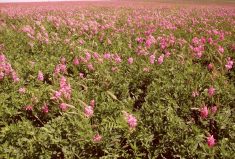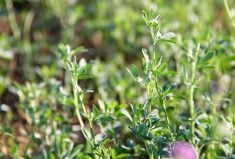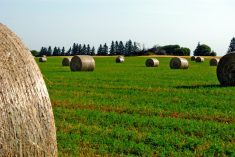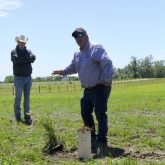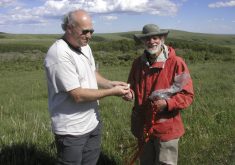Glacier FarmMedia – Producers are seeing their fears realized with light hay cuts and pasture supplies once again running thin.
With the exception of very localized patches of the southeast, which are seeing almost normal growth, most producers harvested 50 to 70 per cent of their normal forage in the first cut, according to John McGregor, hay expert with the Manitoba Forage and Grassland Association. Other areas, like the hard-hit Interlake, saw even lower numbers, with McGregor estimating forage yields closer to 40 per cent of normal.
“We don’t know, unless they get some rains between now and fall, just what additional crop they’re going to be able to pull out of that area,” McGregor said.
Read Also

Why post-drought pasture management matters for beef farmers
Pasture management is always important, but it is especially important following a drought. During these challenging periods, pastures may suffer…
Why it matters: Pastures are drying, producers are feeding and many first hay cuts have been as low as half what producers would typically take, creating a storm of compounding factors that spell hard times for the livestock sector.
It is, unfortunately, not a surprise. A dry spring, on top of dry weather throughout the growing season in 2020, sparked early alarm among producers. In March, experts urged producers to consider forage insurance, given the looming concern. Lack of rainfall throughout the spring and early summer only intensified worry. By mid-May, producers were anxiously watching dugout levels dwindle, although June rains gave some breathing room, greening pastures, recharging some dugouts and adding some hope for later hay in western and central Manitoba,
The first cut was fully as bad as expected, according to Tyler Fulton, president of the Manitoba Beef Producers. The Interlake this year is a “huge area where there are some extreme conditions,” he noted, although other parts of the province are also struggling.
“It’s below average for everybody,” he said. “In some cases, it’s stark. It’s critical. And in other places it’s more manageable.”
On his own farm near Birtle, an area that appears in relative good standing according to raw rain accumulations in May and June, yields are still much lower than normal. One older stand yielded 129 bales over 75 acres, he said. Last year — a year that was, itself, below average — that same field provided 332 bales of the same weight.

Insect pressure
Pests have added yet another complication. Dairy-quality hay producers in eastern Manitoba rushed to harvest due to pressure from alfalfa weevil, according to provincial crop reports in June, while the pest was also noted in the Interlake. Grasshoppers have since cut yet another slice into producer harvest numbers.
Grasshoppers in Fulton’s area are not as extreme as has been reported in places like the Interlake, where producers say the pests are stripping much of what is left of their little forage, although he said his own fields are taking some damage.
What grazing season?
Pasture conditions have done little to ease anxiety.
Some producers have been forced to pull cattle or feed on pasture months early, cutting into a potentially short overwinter feed supply.
“It’s common that there are some dry areas, so it’s hard to compare apples to apples, but it’s evident that we’re in an exceptional circumstance right now… you can’t rule out the possibility that the taps will turn back on, but that doesn’t address most of the issue,” Fulton said. “Most of the pasture growth happens in that first month and a half and we’ve seen that now and it’s locked in and it’s disappointing.”
At least five municipalities in the Interlake had announced a state of agriculture disaster as of July 9, due largely to very poor pasture and hay conditions. Other municipalities indicated that the issue was due to come up in upcoming council meetings.
Conditions in the region have deteriorated enough that producers are selling stock during what is normally the prime of the grazing season, local officials have said, while others noted that some producers started hay harvest, only to stop when it became evident that there was little in the field to cut.
On July 7, almost 500 head hit the sale ring at the Ashern Auction Mart in an emergency cattle sale.

Hay market in limbo
Hay prices have risen slightly, according to McGregor, although he added that not a lot of hay is currently listed, and the province will have to wait until the first cut of beef hay and the second cut for dairy quality is done before hay prices become more concrete.
There have been cases in past years where hay price has gone up, only to fall in autumn when alternate feeds come to market, he said.
“Right now, it’s really a guessing game as to how much hay is going to be available, how much other forage type we’re going to have as far as silage, greenfeed, things like straw, stover, and those are the things that are going to affect where the price of hay is,” he said.
According to the most recent hay report, put out by the forage association in late June, alfalfa prices were up to 11 cents a pound, while alfalfa grass mix ranged from seven to 11 cents and native hay was going for four cents a pound.
Crop insurance writeoffs — while certainly unfortunate for the grain farmer — might also bolster critically low feed supplies.
The Manitoba Beef Producers has collaborated with Manitoba Agricultural Service Corporation (MASC) adjusters to help divert non-viable crops into feed stock.
“There’s considerations like that, for sure,” Fulton said, “but the reality is that we’ve got a commodity market that’s just extremely high right now, whether you talk any feed grains or corn or even canola meal. All of these feeds ingredients don’t make it easy to hold on to animals.”
McGregor noted that, if the decision is left too long, the previously good forage provided by some of those non-viable stands devolves to “empty heads and stalks.”
David Koroscil, manager of claims services with MASC, noted that, until haying is complete, it is hard to say how significantly programs like the Hay Disaster Benefit, payments that trigger automatically for insured producers when forage yields fall below a certain level, may come into play.
“What we’re hearing right now is the yields are down in most areas from what they were last year, so current trends would indicate that there is a strong possibility that it will be triggered again this year,” he said. “It’s just a little too early to tell at this point in time.”
Over 20 per cent of insured producers must see below half of their long-term yield in order for the benefit to trigger.
This year’s challenges mark the fourth season of feed concerns for many parts of the province, including 2019, when critically low hay and pasture supplies had producers selling stock and municipalities in the Parkland and Interlake announcing states of agricultural disaster.
Alexis Stockford is a reporter for the Manitoba Co-operator. Her article appeared in the July 15, 2021 issue.
For more content related to drought management visit The Dry Times, where you can find a collection of stories from our family of publications as well as links to external resources to support your decisions through these difficult times.





